Sir Isaac Newton developed three laws of motion.
Newton's first law - An object will remain at rest or in uniform motion unless compelled to do otherwise by some external force acting on it.
 For example, a book lying on a table will remain there unless some external force moves it. A car travelling at uniform speed will continue to do so unless the brakes or friction are applied (force) or it hits an object (force) which slows its motion or stops it.
For example, a book lying on a table will remain there unless some external force moves it. A car travelling at uniform speed will continue to do so unless the brakes or friction are applied (force) or it hits an object (force) which slows its motion or stops it.
In buildings, most of the framework is stationary and must remain so under the applied forces. Some minimum movements called deflection and deformation (mainly bending and buckling) may occur under loading. If movement occurs that is not allowed for, structural failure may result. Buildings are designed to maintain a state of equilibrium, which is the ability to resist any external loads without moving.
